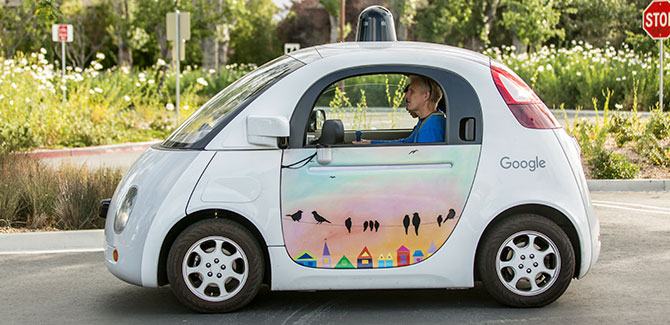For the past 100 years, after the assembly line, progress in the automotive sector has been incremental. Our current mobility system provides everyone with the personal freedom to move about as they please; however, it has greatly impacted our safety, environment, land use, and time. With advancements in technology, including energy efficiency, our transportation system is ready for a transformation. Self-driving cars or autonomous vehicles (AV) are the catalyst that will change our lives, cities, and suburbs.
More than 30 tech companies and automotive makers have been working on their own prototypes of AVs, and this vision is quickly becoming a reality. Companies like Google and Tesla already have prototypes on the road with more than a million miles of testing. Many automotive companies hope to have something tangible for sale as early as 2019.
Phases of Transformation
The first phase of the transformation is what we are seeing now with vehicles having the technology to drive on their own, but a driver is still present behind the wheel. Once they are "street legal" for a brief period, people might own their own fully driverless vehicles, for the freedom of not having to pay attention. But the idea of sending it back home for use by one's partner seems unlikely. The phase soon to follow is the rise of fleets of driverless AVs owned by a limited number of national-level companies providing mobility as a service (MaaS), similar to Uber and Lyft, but without the drivers.
Mobility as a Service
The evolution of MaaS using AV could save the average American family significant money. MaaS is the idea of using AVs when and wherever you want via an on-demand subscription platform instead of owning an AV. The subscription provides you a vehicle when and where ever you need one, and when you're done, it departs to serve someone else. The MaaS business model hypothesizes that people in highly populated areas will give up ownership because of the time-consuming burden of parking and the high cost of ownership. Costs could be reduced from spending about $8,700 annually to own, insure and maintain a vehicle used five percent of the day, to around $2,400 annually for an anywhere, anytime subscription option.
 Google, one of the tech companies manufacturing autonomous vehicles, shows a new prototype of a self-driving car at the Mountain View, California, test facility.
Google, one of the tech companies manufacturing autonomous vehicles, shows a new prototype of a self-driving car at the Mountain View, California, test facility.
The companies delivering this on-demand system and providing these vehicles will be able to deliver low-mobility costs because they're actively using their vehicles 60-70 percent of the time during a 24-hour day. MaaS can deliver a significant number of people over a sizable catchment to a transportation hub, like a train or bus station, without the need for parking. Downtown areas and places like malls and big box corridors that are dominated by parking can repurpose this valuable land for better use. With knowledge of their customer's travel habits, the technology could develop effective carpooling by organizing people with the same origin and destination, as Uber and Lyft have today, but for a cheaper fee.
Moving Forward
The introduction of driverless vehicles is predicted to save approximately 30,000 lives per year in the U.S., according to researchers at McKinsey & Co., as well as many other possible benefits to social welfare, including reducing crashes, fuel consumption, congestion, and pollution; increasing mobility for the disabled; and improving land use. Studies looking at mobility in cities, such as Manhattan and suburban communities in Florida and Michigan have identified that implementing the MaaS concept would require only 25 percent of the cars currently in use in these communities. Extending nationwide and recognizing that some people do like to drive and will want to keep driving their own car, we could eventually see the total number of cars out there decline from today's 240 million to perhaps 100 million or less.
As a transportation engineer, I'm interested to see how this transformation will affect our infrastructure. It is worth noting that trucks are leading this change. Fleet owners will eventually own most of the AV cars and trucks, and will have a vested interest in lowering maintenance costs by having better roads and highways. Maintaining our transportation systems could become a true public-private partnership between the state departments of transportation and the MaaS trade associations. We're at the beginning of a truly transformational era for transportation. Much like the rise of the personal computer or the smart phone, there will be significant collateral effects on our lives, our social sphere, and the world we move about in.